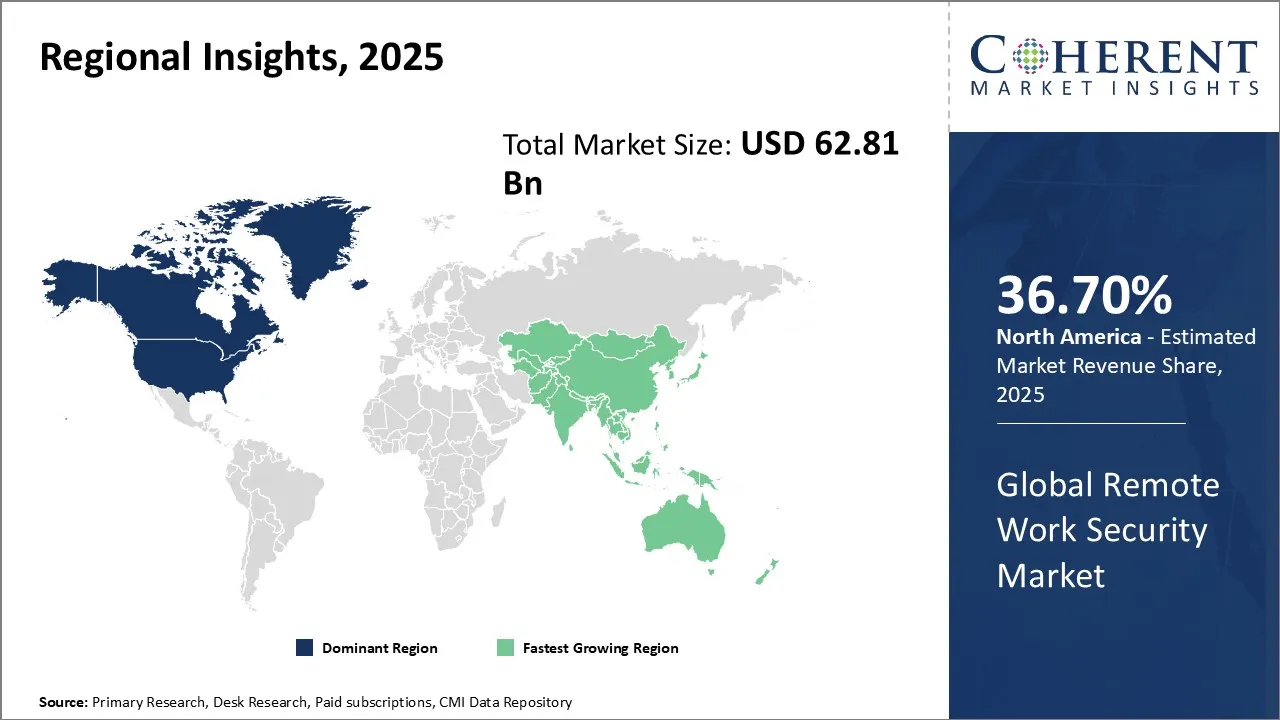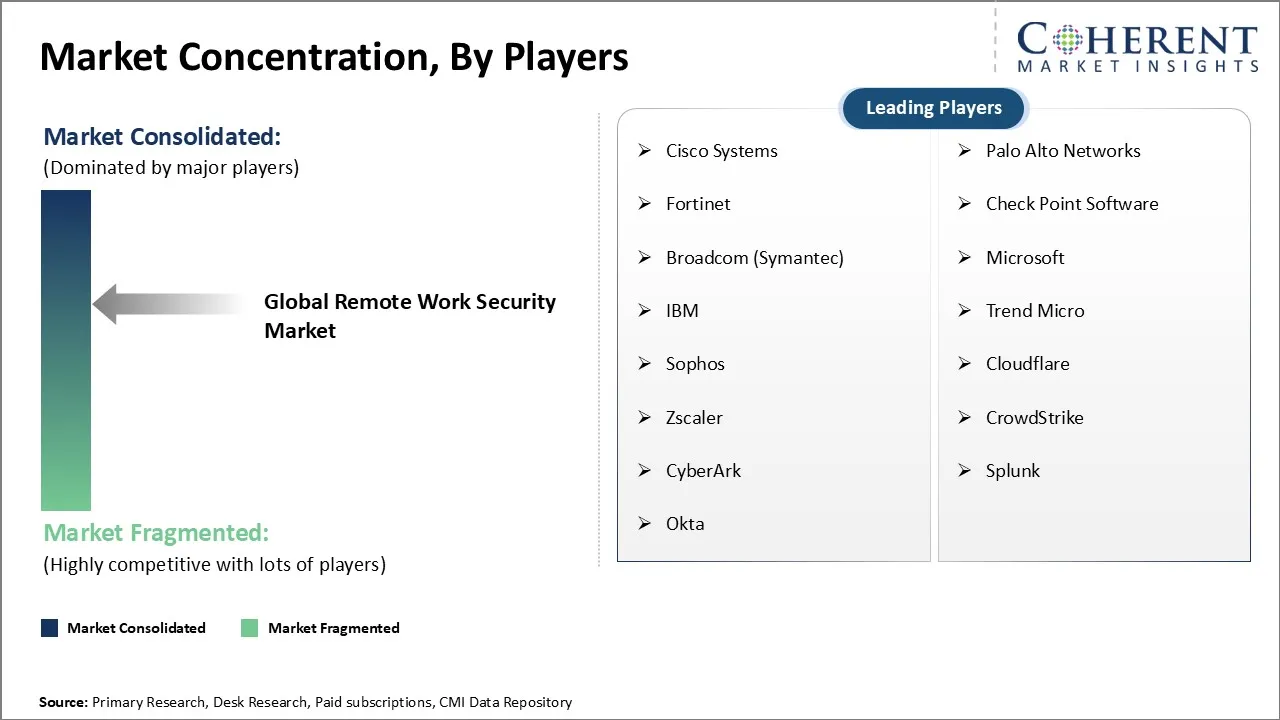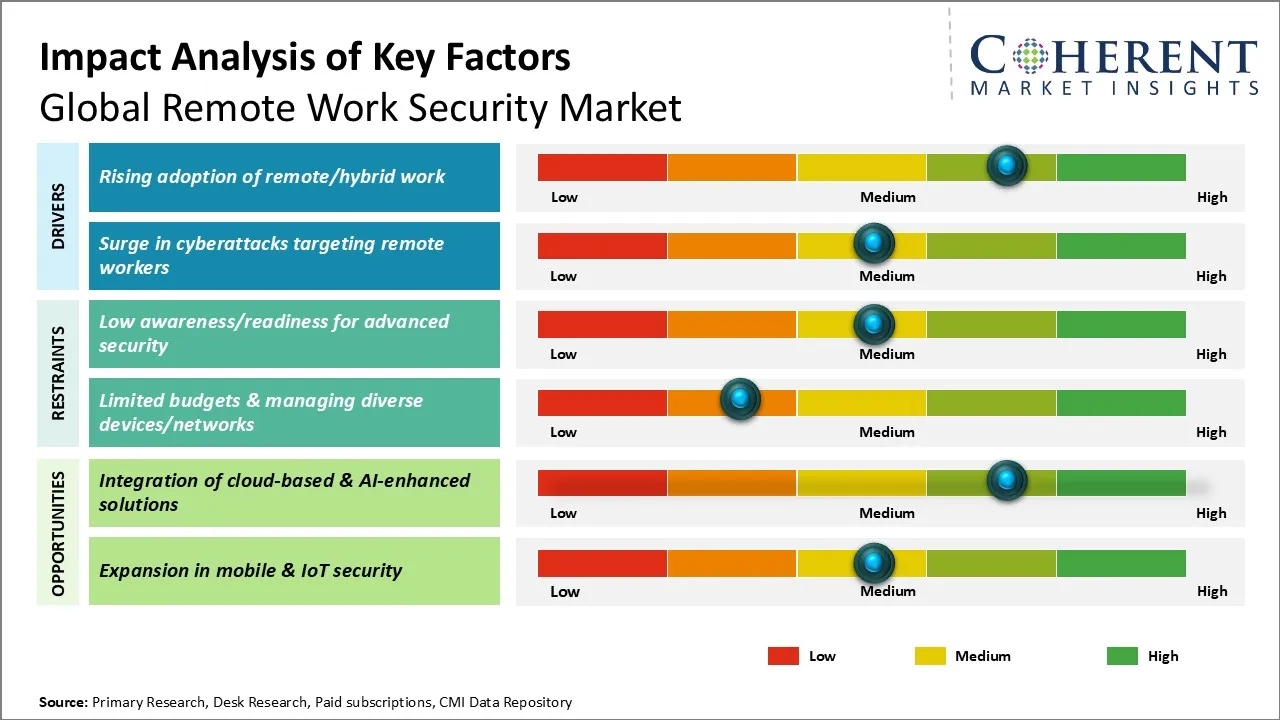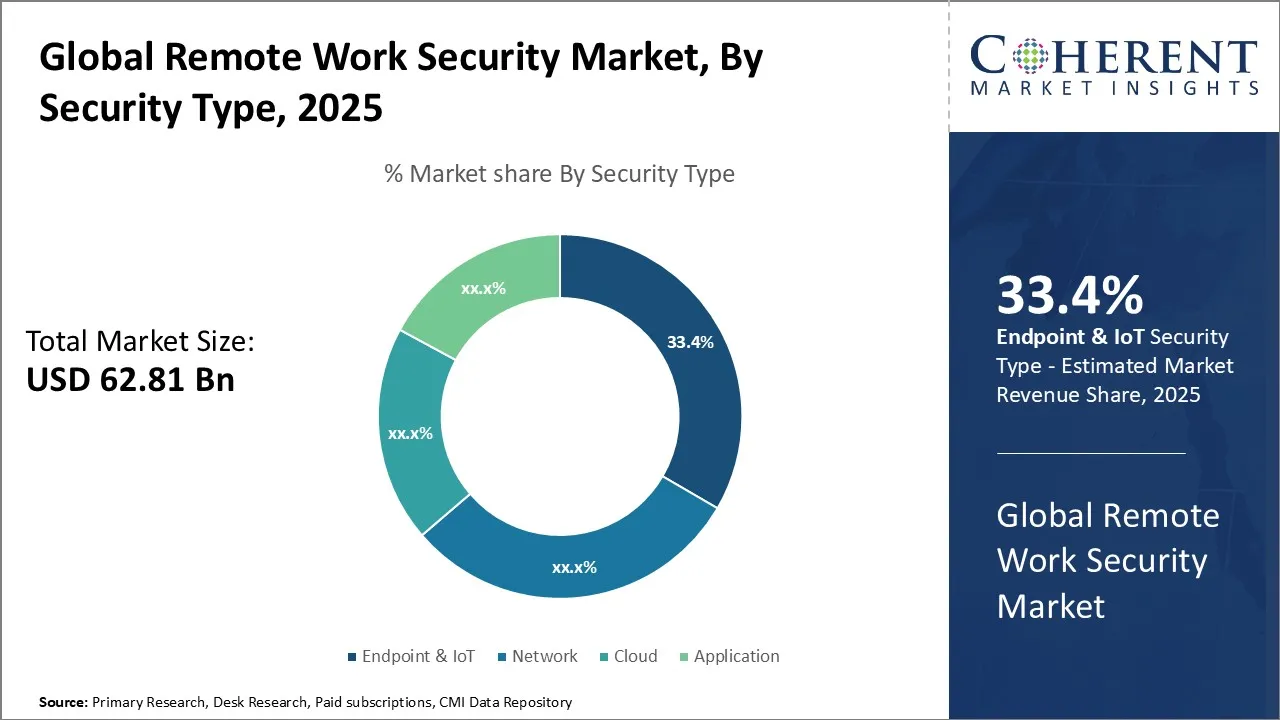Global Remote Work Security Market Size and Forecast – 2025-2032
The Global Remote Work Security Market is estimated to be valued at USD 62.81 billion in 2025 and is expected to reach USD 244.09 billion by 2032, exhibiting a compound annual growth rate (CAGR) of 21.4% from 2025 to 2032.
Key Takeaways of the Remote Work Security Market:
- The Endpoint & IoT segment leads the market, holding an estimated share of 33. 4% in 2025.
- North America is estimated to lead the market with a share of 36. 7% in 2025.
- Asia Pacific, holding a share of 20. 1% in 2025, is projected to be the fastest growing region.
Market Overview:
The market trend indicates a significant acceleration driven by the permanent adoption of hybrid work models, increasing cyber threats targeting remote workers, and stringent regulatory compliance requirements. Organizations are making investments in zero-trust security architectures and endpoint protection solutions to protect sensitive data and maintain operational continuity. Cyberattacks are getting more sophisticated, and the trend of remote work has expanded the attack surface, adding to the challenge.
Current Events and their Impact:
|
Current Events |
Description and its impact |
|
Continued Hybrid Work Policies Post-Pandemic |
|
|
Regulatory and Compliance Evolution |
|
Uncover macros and micros vetted on 75+ parameters: Get instant access to report
Global Remote Work Security Market Insights, by Security Type – Rising Remote Device Vulnerabilities Drive Endpoint & IoT Security Dominance
The Endpoint & IoT is projected to account for the highest share of 33.4% in the remote work security market in 2025. The fundamental shift toward distributed work models has dramatically increased the variety and volume of devices accessing corporate networks from unsecured locations. Remote workers use personal laptops, smartphones, tablets, smart home devices, and different IoT sensors, each of which acts as a potential entry point for cyber threats. Endpoint & IoT security solutions address critical vulnerabilities arising from unmanaged device access patterns. Remote workers frequently switch between home networks, public Wi-Fi, and mobile hotspots, exposing corporate data to intercepted communications and malware infiltration.
Organizations are understanding that traditional perimeter security models do not provide adequate protection when the workforce operates from distributed locations. Endpoint security platforms provide essential capabilities, including real-time threat detection, device compliance monitoring, data loss prevention, and remote device management. Additionally, regulatory compliance requirements in industries such as healthcare, finance, and government mandate strict endpoint protection measures. Organizations face significant penalties for data breaches originating from unsecured remote devices, driving substantial investments in comprehensive endpoint security frameworks.
Impact of AI on the Remote Work Security Market:
- Artificial Intelligence (AI) is transforming remote work security by enabling faster, smarter, and more adaptive threat detection and response systems. With the proliferation of remote endpoints, traditional security systems often fall short in identifying sophisticated cyber threats in real time.
- AI-driven security tools, such as behavior-based anomaly detection and automated incident response, are helping organizations identify suspicious activity across dispersed devices and networks more efficiently. These systems can autonomously analyze vast datasets to detect potential breaches, reducing human dependency and response time, a critical advantage in remote and hybrid work models.
- CrowdStrike’s Falcon platform uses AI and machine learning to deliver real-time endpoint protection. In 2023, CrowdStrike helped a global consulting firm prevent a ransomware attack that had infiltrated an employee's remote device via a phishing email. The AI engine detected abnormal file access behavior within seconds and quarantined the threat before it could spread across the firm’s cloud infrastructure.
Regional Insights:

To learn more about this report, Download Free Sample
North America Remote Work Security Market Analysis and Trends
North America, holding an estimated share of 36.7% in 2025, dominates the remote work security market. The region's dominance is primarily attributed to the presence of major technology corporations such as Microsoft, Cisco Systems, VMware, and CrowdStrike, which have developed comprehensive remote work security platforms. Palo Alto Networks introduced its AI-powered Autonomous Digital Experience Management (ADEM) module as part of its Prisma Access platform in late 2023. These companies leverage their extensive research and development capabilities to create integrated solutions that address the complex security challenges of distributed workforces. Microsoft's comprehensive security suite, including Microsoft Defender and Azure Security Center, has become instrumental in securing remote work environments across enterprises.
Government policies in North America have significantly influenced market development, with regulatory frameworks like SOX compliance, HIPAA requirements, and state-level data protection laws driving organizations to invest heavily in secure remote work infrastructure.
Asia Pacific Remote Work Security Market Analysis and Trends
The Asia Pacific region, holding a share of 20.1% in 2025, exhibits the fastest growth in the remote work security market, driven by rapid digital transformation initiatives and the increasing adoption of hybrid work models across diverse economies. The region's growth is fueled by several key factors, including government-led digitization programs, increasing cybersecurity awareness, and the presence of a large, tech-savvy workforce. In India, companies like Tata Consultancy Services and Infosys have developed robust remote work security frameworks to support their global delivery models, while also offering these solutions to other enterprises.
In 2023, NEC launched its “Secure Access Service Edge (SASE)” solution tailored for remote enterprises across Japan and Southeast Asia. This innovation combines network security functions (like firewall-as-a-service and secure web gateways) with Zero Trust Network Access (ZTNA)
Remote Work Security Market Outlook for Key Countries
U.S. Remote Work Security Market Analysis and Trends
The U.S. market continues to lead global innovation in remote work security solutions, driven by a mature ecosystem of technology vendors, service providers, and end-user organizations. Major players like CrowdStrike, Palo Alto Networks, and Fortinet are headquartered in the US and continue to develop cutting-edge solutions that address evolving threat landscapes. The country's strong regulatory environment, including federal cybersecurity mandates and industry-specific compliance requirements, drives consistent demand for advanced security solutions. Silicon Valley remains the epicenter of innovation, with companies like Zscaler pioneering zero-trust network access solutions specifically designed for remote work environments.
China Remote Work Security Market Analysis and Trends
China demonstrates significant growth potential driven by domestic technology giants and government-supported digital transformation initiatives. Alibaba Cloud, Tencent Cloud, and Huawei are developing comprehensive security platforms that integrate remote work capabilities with advanced threat detection and response features. The country's unique regulatory environment, including data localization requirements and cybersecurity laws, has created opportunities for domestic vendors to develop specialized solutions. Chinese companies are increasingly investing in artificial intelligence and machine learning technologies to enhance their security offerings, with firms like Qihoo 360 and Venustech leading the development of next-generation remote work security solutions tailored for local market requirements.
India Remote Work Security Market Analysis and Trends
India continues to lead the Asia Pacific market for remote work security implementation and management, with companies like Wipro, HCL Technologies, and Tech Mahindra providing comprehensive security services to organizations worldwide. The country's large pool of cybersecurity professionals and cost-effective service delivery models make it an attractive destination for remote work security outsourcing.
Japan Remote Work Security Market Analysis and Trends
Japan remote work security market expansion is driven by traditional enterprises adopting remote work policies for the first time, creating significant demand for comprehensive security solutions. Companies like NTT Communications and SoftBank are providing integrated telecommunications and security services to support this transition.
Market Players, Key Development, and Competitive Intelligence:

To learn more about this report, Download Free Sample
Key Developments:
- In March 2025, CyberArk and Device Authority, in collaboration with Microsoft, launched a solution that strengthens and scales connected device authentication to enterprise applications with Zero Trust principles. It helps manufacturers reduce cyber risk from connected devices on factory floors and edge environments with robust identity security, automated access management, and device lifecycle protection.
- In February 2025, CyberArk, the identity security company, announced a new integration with SentinelOne’s AI-powered cybersecurity platform, SentinelOne Singularity, to protect against privileged access misuse. Integrating the two cyber leaders’ platforms brings together the robust endpoint detection and response capabilities of SentinelOne’s market-leading Singularity Endpoint solution and CyberArk Endpoint Privilege Manager.
- In February 2025, CyberArk acquired Zilla Security, a leader in modern Identity Governance and Administration (IGA) solutions. Zilla’s AI-powered IGA capabilities expanded CyberArk’s industry-leading Identity Security Platform with scalable automation that enables accelerated identity compliance and provisioning across digital environments.
- In September 2024, Zscaler, Inc. announced a new set of AI and Zero Trust integrations with the CrowdStrike Falcon cybersecurity platform to advance security operations. The latest integrations with Zscaler Zero Trust Exchange, Zscaler Data Fabric for Security, and CrowdStrike Falcon Next-Gen SIEM modernize security operations to provide advanced threat detection, response, and risk management.
Top Strategies Followed by Global Remote Work Security Market Players
- Established Players: Leading companies in the remote work security sector, such as CrowdStrike, Palo Alto Networks, and Microsoft, prioritize extensive R&D investment to develop cutting-edge cybersecurity solutions.
- In 2023, Cisco Systems announced a USD 1 billion investment over five years into developing AI-enhanced cybersecurity solutions, including next-generation Secure Access Service Edge (SASE) platforms tailored for hybrid and remote workforces. This includes integrating AI/ML capabilities into Cisco SecureX to proactively detect anomalies in remote endpoints across global networks.
- Mid-Level Players: Mid-tier companies target small-to-medium enterprises by offering streamlined security packages that provide essential protection without the complexity and cost associated with enterprise-grade solutions.
- In 2023, Seqrite, the enterprise arm of Quick Heal Technologies (India), launched “Seqrite HawkkProtect”, a cost-effective cloud-based Zero Trust Security solution for small and mid-sized businesses.
- Small-Scale Players: Smaller companies excel through niche specialization, targeting specific industry verticals or unique security challenges.
- Perimeter 81, a smaller cybersecurity vendor based in Israel with a growing presence in Asia-Pacific, has tailored its SASE platform for startups and remote developer teams. In 2023, it introduced tools specifically designed to secure remote access to cloud-based development environments (e.g., GitHub, AWS)
Market Report Scope
Remote Work Security Market Report Coverage
| Report Coverage | Details | ||
|---|---|---|---|
| Base Year: | 2024 | Market Size in 2025: | USD 62.81 Bn |
| Historical Data for: | 2020 To 2024 | Forecast Period: | 2025 To 2032 |
| Forecast Period 2025 to 2032 CAGR: | 21.4% | 2032 Value Projection: | USD 244.09 Bn |
| Geographies covered: |
|
||
| Segments covered: |
|
||
| Companies covered: |
Cisco Systems, Palo Alto Networks, Fortinet, Check Point Software, Broadcom (Symantec), Microsoft, IBM, Trend Micro, Sophos, Cloudflare, Zscaler, CrowdStrike, CyberArk, Splunk, and Okta |
||
| Growth Drivers: |
|
||
| Restraints & Challenges: |
|
||
Uncover macros and micros vetted on 75+ parameters: Get instant access to report
Market Dynamics

To learn more about this report, Download Free Sample
Global Remote Work Security Market Driver - Rising Adoption of Remote/hybrid Work
Organizations worldwide are embracing remote and hybrid work arrangements as permanent operational strategies. This paradigm shift has created unprecedented security challenges as employees access corporate networks, applications, and sensitive data from diverse locations using various devices and internet connections. Traditional perimeter-based security models have become obsolete, forcing organizations to reimagine their cybersecurity infrastructure to accommodate distributed workforces.
In 2023, Microsoft reported that over 80% of Fortune 500 companies had adopted hybrid work models and upgraded to Microsoft Defender for Endpoint, part of its Microsoft 365 Defender suite. The surge in hybrid deployments led Microsoft to expand its threat protection capabilities across home networks and unmanaged devices, supporting secure remote access. Their rollout of “Endpoint DLP” (Data Loss Prevention) for hybrid work environments directly reflects this growing demand.
Companies are investing heavily in comprehensive security solutions that can protect against evolving threats targeting remote workers, including secure access technologies, endpoint protection, and identity management systems. The permanent nature of remote work arrangements has compelled businesses to move beyond temporary security patches to implement robust, scalable security frameworks that ensure data protection regardless of employee location.
Global Remote Work Security Market Opportunity: Integration of Cloud-Based and AI-Enhanced Security Solutions
Cloud-based security platforms offer scalable, cost-effective solutions that eliminate the need for extensive on-premises infrastructure, making advanced security accessible to organizations of all sizes. AI-enhanced capabilities enable real-time threat detection, behavioral analysis, and automated response mechanisms that significantly reduce the burden on IT teams while improving security efficacy. For instance, in 2024, Zscaler launched its AI-driven “Risk360” platform, which integrates with its cloud-native Zero Trust Exchange. The platform uses machine learning to assess and visualize user risk across remote environments, enabling organizations to automate policy enforcement based on behavior patterns.
Machine learning algorithms can identify anomalous patterns in user behavior, network traffic, and system activities, providing proactive threat mitigation that traditional signature-based solutions cannot match. The integration of these technologies facilitates the development of comprehensive Security-as-a-Service (SECaaS) offerings, enabling organizations to access enterprise-grade security capabilities through subscription models.
Analyst Opinion (Expert Opinion):
- The shift from reactive to predictive security, powered by AI and machine learning, is redefining endpoint and cloud protection. Vendors integrating behavioral analytics and autonomous response capabilities are poised to lead, especially as remote attack surfaces continue to expand.
- Zero Trust has evolved from a strategic concept to a practical necessity. Its adoption is accelerating across remote work ecosystems, driven by regulatory pressure and rising cloud workloads. Emerging solutions now combine ZTA with SASE and identity-based access models for seamless and secure remote connectivity.
- Enterprises are moving away from disjointed point solutions toward consolidated cloud-native security platforms. Technologies that unify endpoint, network, and identity protection — while maintaining performance for hybrid workers — are gaining significant traction, especially among large multinationals and digital-first SMEs.
Market Segmentation
- Security Type Insights (Revenue, USD Bn, 2020 - 2032)
-
- Endpoint & IoT
- Network
- Cloud
- Application
- Regional Insights (Revenue, USD Bn, 2020 - 2032)
- North America
- U.S.
- Canada
- Latin America
- Brazil
- Argentina
- Mexico
- Rest of Latin America
- Europe
- Germany
- U.K.
- Spain
- France
- Italy
- Russia
- Rest of Europe
- Asia Pacific
- China
- India
- Japan
- Australia
- South Korea
- ASEAN
- Rest of Asia Pacific
- Middle East
- GCC Countries
- Israel
- Rest of Middle East
- Africa
- South Africa
- North Africa
- Central Africa
- North America
- Key Players Insights
- Cisco Systems
- Palo Alto Networks
- Fortinet
- Check Point Software
- Broadcom (Symantec)
- Microsoft
- IBM
- Trend Micro
- Sophos
- Cloudflare
- Zscaler
- CrowdStrike
- CyberArk
- Splunk
- Okta
Sources
Primary Research Interviews:
Stakeholders:
- IT Security Managers from Multinational Enterprises
- CISOs from Remote-First Tech Firms
- Cybersecurity Software Developers and Architects
- Cloud Infrastructure Providers (e.g., remote networking teams)
- Managed Security Service Providers (MSSPs)
- Remote Work Policy Advisors & Digital Workplace Consultants
- Regulatory Experts specializing in data privacy and cybersecurity compliance
Databases:
- Cyber Risk Index Archive
- International ICT Usage Data Repository
- Global Workforce Analytics Database
- ITU Cybersecurity Readiness Index
- U.S. Department of Labor – Telework Survey Reports
Magazines:
- Cybersecurity Today
- Information Security Magazine
- Digital Workspace Monthly
- Cloud & Endpoint Security Digest
- Remote Infrastructure Journal
Journals:
- Journal of Cybersecurity and Remote Work
- AI in Network Security Journal
- Journal of Information Assurance and Policy
- Cloud Computing and Security Technologies Journal
- Journal of Workplace IT Management
Newspapers:
- The Tech Insider (U.S.)
- Cyber Affairs Weekly (U.K.)
- InfoSec Times (India)
- The Asia Cyber News Review
- Security & Digital Economy Report
Associations:
- Global Cybersecurity Alliance (GCA)
- Remote Work Technology Consortium (RWTC)
- Cloud Security Alliance (CSA)
- Asia-Pacific Information Security Council (APISC)
- European Data Protection Board (EDPB)
Public Domain Sources:
- World Bank – ICT and Employment Reports
- U.S. Census Bureau – Home-Based Work Statistics
- EUROSTAT – Digital Economy and Society Statistics
- United Nations Conference on Trade and Development (UNCTAD)
- ResearchGate (for open-access cybersecurity research)
Proprietary Elements:
- CMI Data Analytics Tool, Proprietary CMI Existing Repository of Information for the Last 8 Years
Share
Share
About Author
Monica Shevgan has 9+ years of experience in market research and business consulting driving client-centric product delivery of the Information and Communication Technology (ICT) team, enhancing client experiences, and shaping business strategy for optimal outcomes. Passionate about client success.
Missing comfort of reading report in your local language? Find your preferred language :
Transform your Strategy with Exclusive Trending Reports :
Frequently Asked Questions
EXISTING CLIENTELE
Joining thousands of companies around the world committed to making the Excellent Business Solutions.
View All Our Clients


